Native and Non-Native Turtle Species of North Carolina
Module Goals
- Be able to identify turtle species that are native to North Carolina
- Be able to identify turtle species that are invasive/not native to North Carolina
- Know how to develop a plan for what to do if a non-native turtle presents to your clinic
If you would like to listen to an audio recording of this material, please click here. (Duration: 14:45)
Introduction
The first step to providing medical care to an injured turtle is being able to identify what species it is, as each species has unique characteristics related to its biology that may affect your treatment plan. In this module, you will be introduced to the 16 native turtle species in North Carolina, as well as some non-native species that you may encounter. Please note that this module will not cover sea turtles, as these species should be transferred to qualified sea turtle facilities.
Native Species
There are 16 species of non-sea turtles that can be found in North Carolina, though some of them are only found in certain regions of the state. Explore the different species below, paying special attention to those species which are found in your region of the state. This module will focus primarily on the identification of species. Specific husbandry and diet information can be found in a later module.
Range: All of North Carolina
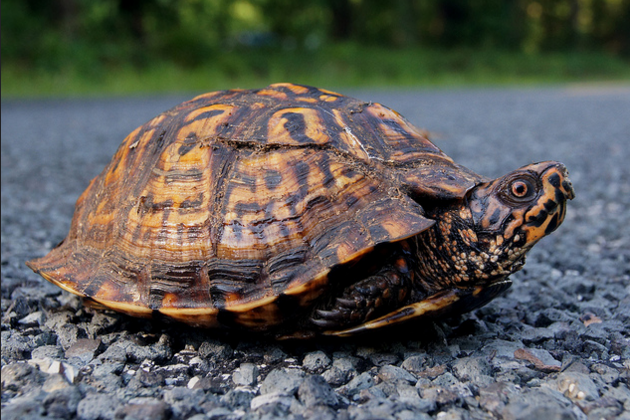
This turtle is one of the most common turtles that we see at the Turtle Rescue Team. They are a terrestrial turtle, but still generally live near aquatic environments. As adults, they reach lengths of up to 6-8 inches. They get their name from their hinged plastron, which allows them to fully retract their head and legs into their shell when threatened, called “boxing.”
Sexing: In adult turtles, males generally have brighter coloration, red eyes, a concave plastron, and longer tails. Females tend to be more brown in coloration with a flat plastron and shorter tails. It can be harder to determine the sex in juvenile box turtles.
Specific Considerations: Box turtles are very commonly hit by cars while searching for mates or nesting sites during the spring and summer after it rains. They are also commonly struck by landscaping equipment or attacked by dogs. Box turtles may accidentally entrap their legs, heads, or tails when they box.
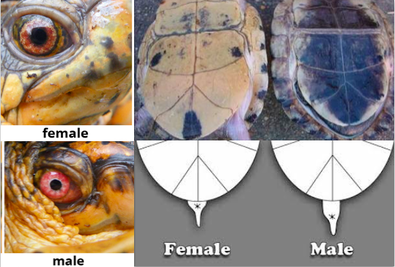

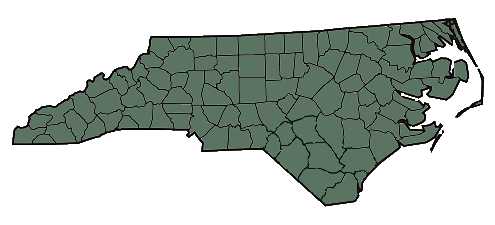
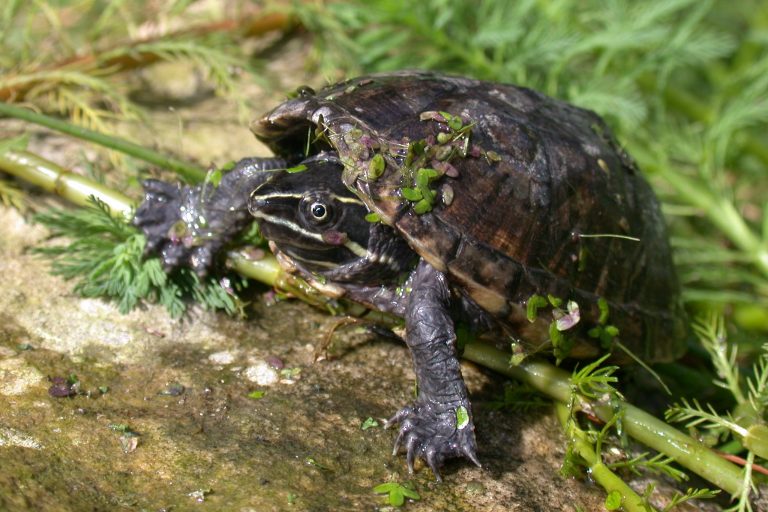
These turtles are mostly aquatic and have a distinctive musky smell due to a secretion from their anal glands – they’re sometimes called “stinkpot turtles.” Like box turtles, musk turtles have hinged plastrons that allow them to escape from predators. This turtle is found across the entire state of North Carolina – unlike the stripe-necked musk turtle, which is only found in the western part of the state (see below). The turtle can be identified by having two stripes on their face. As these turtles do not tend to venture far away from water, they are seen less frequently than other turtle species.
Sexing: Males have thick, sharp, horny tails while females have smaller, more blunted tails.
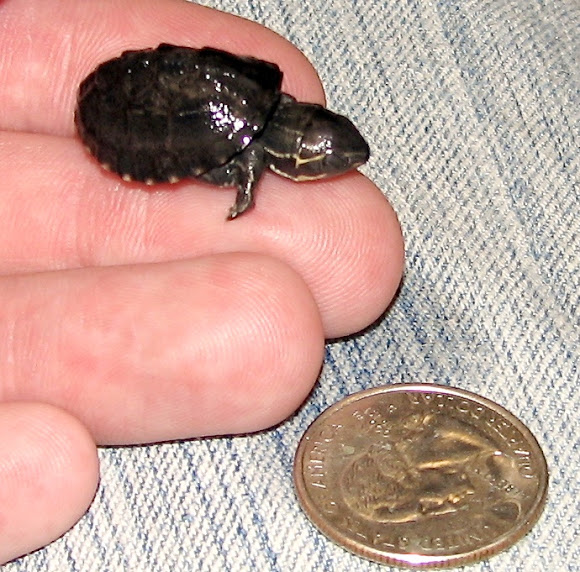
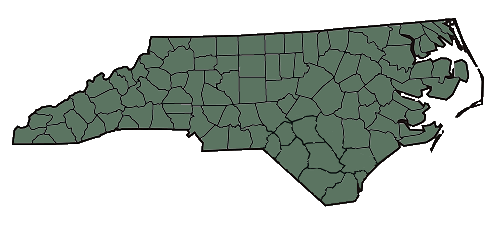
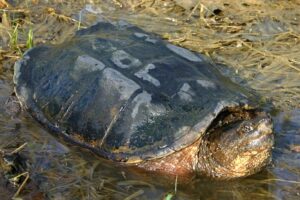
This turtle is rarely misidentified – it has a very distinct appearance and is commonly seen by the Turtle Rescue Team. Snapping turtles can grow to be quite large – up to 14 inches in length. These turtles have large heads, a long neck, and small unhinged plastrons. They are commonly encountered on land during their nesting season. Snapping turtles are known to be aggressive – handlers should never place their hands near the front half of the turtle, as they are able to very quickly reach their long necks around to give a powerful bite. They can be lifted by the back of their shell.
Special Considerations: Snappers are frequently hit by cars while crossing roads. Their instinct is to make themselves appear bigger and more threatening when a car approaches, and as a result they frequently have injuries to the top of their carapace.
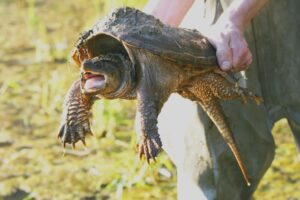

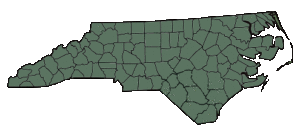
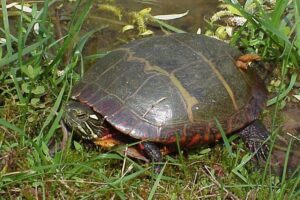
This aquatic turtle has a flat carapace with large scutes, an unhinged plastron, and very bright coloration. Adults are usually between 5-8 inches in length. They can be seen basking near bodies of water but do venture far enough away from water to encounter vehicles. They are not found in the southern-most part of the state.
Sexing: Males have longer claws and tails than females.
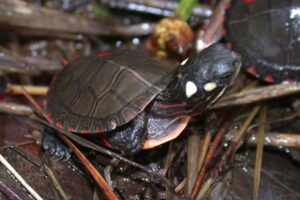
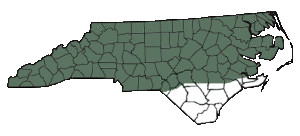
Range: Eastern North Carolina
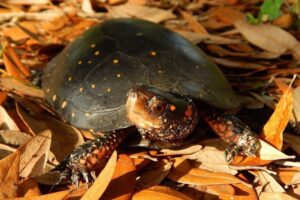
The spotted turtle is aquatic and is generally found near marshes or similar habitats and are more commonly seen in spring. They are small – adults only grow to about 3-5 inches – and have distinctive spots on their shells. The carapace is usually darker in color than the plastron, which is usually yellow or pink.
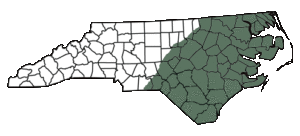

Another species commonly seen by the Turtle Rescue Team, the yellow-bellied slider can be difficult to distinguish from the river cooter (see below). While juveniles have bright yellow markings on their shells, adults lose this coloration, having just faint yellow lines on the carapace with a yellow plastron. Sliders have a yellow y-shaped spot behind the eye, rounder jaws, and are more dome-shaped than cooters.
This species can also be difficult to differentiate from the red-eared slider, which is invasive in North Carolina (see below). Yellow bellied sliders will lack a red streak behind the eye, but it is possible for yellow-bellied sliders to hybridize with red-eared sliders.
Sexing: Sexing can be difficult in this species, but males tend to have longer claws and longer tails than females.
Special Considerations: While these turtles frequently present to the Turtle Rescue Team after being hit by a car, they are also commonly brought in for accidental fish hook encounters.
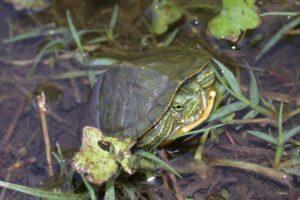
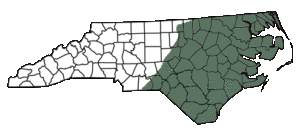
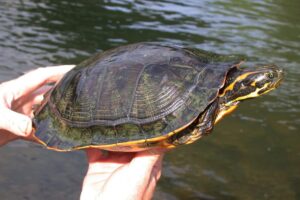
Cooters can grow to be fairly large, and can be differentiated from yellow-bellied sliders by their overall flatter shape and prominent black markings on the plastron. Cooters also have flatter chins than sliders. It is difficult to distinguish the river cooter from the Florida cooter (see below), but river cooters will sometimes have a “C” on the second side scute while Florida cooters do not. River cooters will hybridize with Florida cooters. These turtles are frequently seen basking near bodies of water, especially rivers and large streams. Adults can grow up to 13 inches in length.
Sexing: Males have longer claws than females.
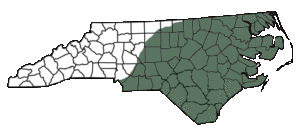
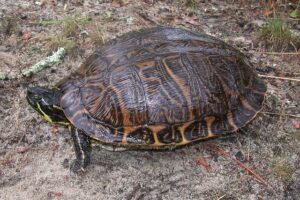
This turtle looks very similar to the river cooter (see above), but lacks a “C” on the second side scute. Generally, Florida cooters prefer wetlands and marshes while river cooters are more likely to inhabit rivers and large streams, which is another way to differentiate between the two species. The Florida cooter can hybridize with both the river cooter and the Northern red-bellied turtle.
Sexing: Males have longer claws than females.
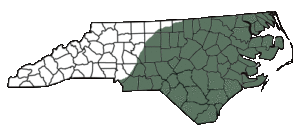
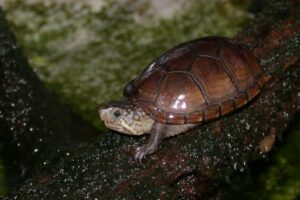
This small semi-aquatic turtle is sometimes mistaken for the common musk turtle (see above) in eastern North Carolina. However, the mud turtle lacks the two stripes on its head. Mud turtles have double-hinged plastrons and can grow to be up to 5 inches in length. They prefer shallow, slow-moving water and are sometimes found in brackish marshes. As hatchlings, mud turtles may look like hatchling snapping turtles, but can be distinguished by their hinged plastrons and shorter tail.
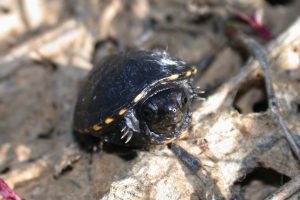
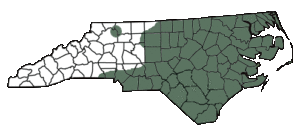
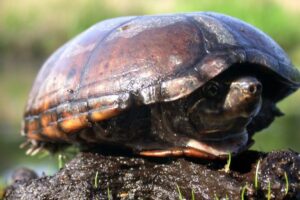
This mud turtle is very similar to the eastern mud turtle (see above). While it can have three stripes on its carapace (hence the name), sometimes these stripes are not visible. Like the eastern mud turtle, this turtle prefers shallow stagnant water.
Sexing: Males have longer tails than females.
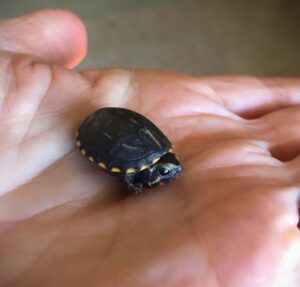

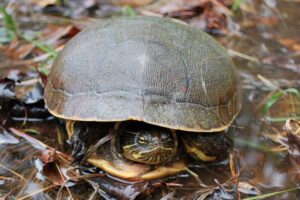
These turtles can sometimes look like yellow-bellied sliders. They have textured shells as well as vertical stripes on the hind legs, and their carapace is usually not as ornate or colorful as sliders. Chicken turtles have hingeless plastrons and grow up to 9 inches in length. They are usually found in sluggish water, such as in marshes.
Sexing: Females are larger than males.
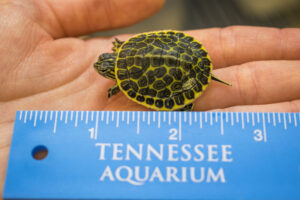
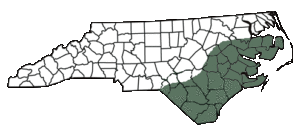
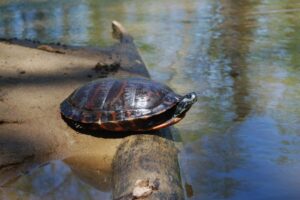
This turtle can look like a river cooter, but generally has some red markings and is, overall, darker in color with black skin. This turtle also has a more restricted range than the river cooter and is only found in the northeastern part of the state. They will sometimes hybridize with Florida cooters. This turtle is considered threatened, mostly due to competition from non-native red-eared sliders (see below).
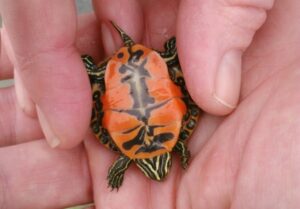
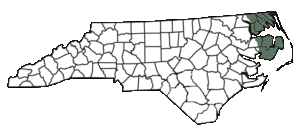
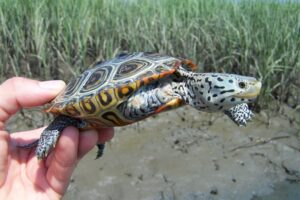
This turtle is really only found along the coastlines of North Carolina – usually in coastal marshes and tidal creeks. Diamondback terrapins prefer brackish water and have ornate patterns on their shells but have high variation in coloration. These are a threatened species, affected by hunting and crab traps.
Sexing: Females are larger than males, with females growing up to 9 inches and males being only about 6 inches long.
Special Considerations: These turtles need to be held in brackish water with a specific gravity of about 1.014. This can be accomplished using aquarium salt and fresh water. If you have a terrapin in your care, you will also need to allow it to soak in fresh water for about 15 minutes a day.
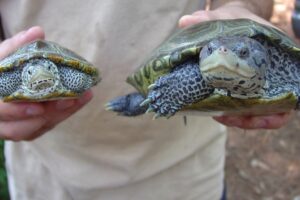
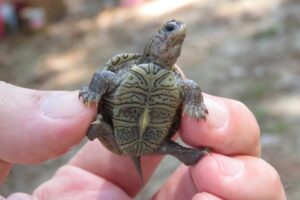
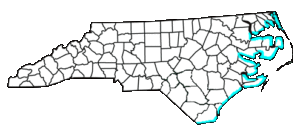
Range: Western North Carolina
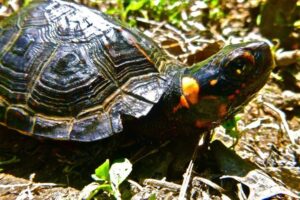
This tiny turtle has a dark-colored shell, hingeless plastron, and a distinctive orange or yellow blotch on the head and neck. They only grow to be up to 4 inches in length as adults. These turtles are not commonly seen as they tend to bury themselves in mud most of the time in bogs and wetlands. This species is considered threatened due to habitat loss and the pet trade.
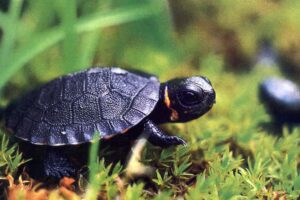
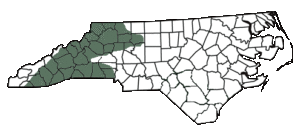
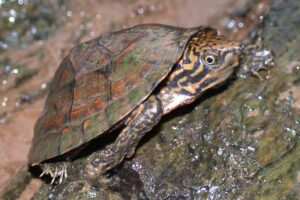
This musk turtle can be distinguished from the common musk turtle (see above) by the markings on its head. Common musk turtles have two stripes on their heads, while stripe-necked musk turtles have more ornate markings on their heads with a series of stripes on their necks. This species has fleshy “barbles” on their chins and can grow to be between 3-5 inches in length. Stripe-necked musk turtles are rare in North Carolina.
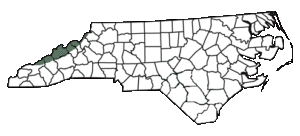
Range: South-central North Carolina
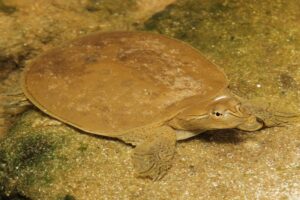
This is one of the more unique turtles in North Carolina because the carapace and plastron are covered by a layer of skin. Spiny softshell turtles also have long necks and a long nose that they use like a snorkel. They are almost always found in water and rarely come on land.
Sexing: Females can be significantly larger than males. Females can be up to 7-12 inches, and males only 5-9 inches.
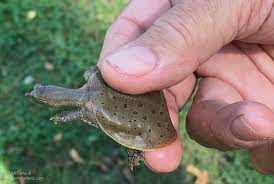
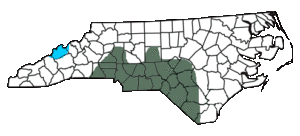
Non-Native Species
The main non-native species we see in North Carolina is the red-eared slider (Tracheyms scripta elegans), which is commonly kept as a pet turtle. It is native to midwestern United States, but has been introduced into several areas – including North Carolina – due to people releasing unwanted pets into the wild. Red-eared sliders can out-compete native turtles for food and basking sites, and they also hybridize with yellow-bellied sliders. When we receive injured red-eared sliders or hybrids at the Turtle Rescue Team, we typically try to find a permanent home for them following treatment.
Red-eared sliders and their hybrids can be identified by the red streak on either side of the head.
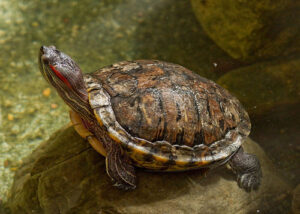
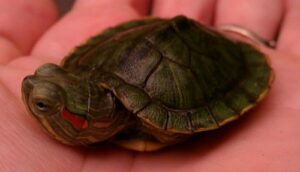
Rarely, people will bring other non-native pet turtles to the Turtle Rescue Team. Many people keep tortoises as pets, and sometimes these tortoises escape from their enclosures and can be hit by cars on nearby roadways. Typically, we try to find the owners of these tortoises for referral to an exotic animal veterinarian. Tortoises should never be released into the wild, because they are desert animals that are not adapted to survive in North Carolina.
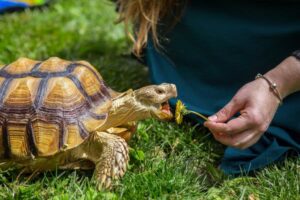
Additional Resources
- Herps of NC Website for the identification of native turtles and more information on their biology
- Reptile Rescue Organizations for information on what to do with non-native species
-
- BeWild NC (Durham)
-
- Piedmont Reptile Rescue (Burlington)
-
- Fresh Start Rescue (Coastal NC)
-
- CCSB Reptile Rescue (Winston Salem)
Key Concepts
- There are 16 native turtle species in North Carolina.
- The Eastern box turtle is found in every county in NC and is one of the most commonly injured turtles presented to wildlife clinics
- Other commonly injured turtles that present to the Turtle Rescue Team in Raleigh include yellow-bellied slider, river cooter, and common snapping turtle – different counties may experience different frequencies in which turtles are most common.
- Red-eared sliders are non-native turtles that are frequently found in the wild and should be re-homed.
- Pet tortoises that escape from their homes may also experience similar injuries to wild turtles.
Test your Knowledge! Previous Module Next Module Table of Contents
